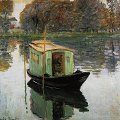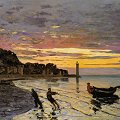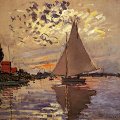Claude Monet
Claude Monet became one of the best known artists in history. He was the leader of Impressionists, a group of artists who rebelled against the traditional method of painting. Traditional method was called academic method - paintings were made usually in dark, sharp colors, they were showing as much detail as possible, and their topic was usually an important event, well known person, or similar topic.
Impressionists didn't want to paint that way. Instead they wanted to create paintings that captured the beauty of their surroundings, and the mood of the scene. Impressionists' paintings would usually show beauty of the nature, friends or family members of the artists; these paintings were made with short brush strokes - and they were not sharp at all.
 Monet enjoyed outdoor
painting very much and became a big enthusiast of it. Most of all he
loved to paint nature and landscapes, but also liked painting people
in the beautiful surroundings. He was using the short brush strokes,
which often looked rather like spots of paint, not lines. For this
reason his paintings seemed to some people messy and unfinished.
Often, when you looked at his painting from a short distance you
couldn't see what it was, but if you stepped away you could see a
beautiful scene. This was a completely new way of painting that became
the mark of Impressionism.
Monet enjoyed outdoor
painting very much and became a big enthusiast of it. Most of all he
loved to paint nature and landscapes, but also liked painting people
in the beautiful surroundings. He was using the short brush strokes,
which often looked rather like spots of paint, not lines. For this
reason his paintings seemed to some people messy and unfinished.
Often, when you looked at his painting from a short distance you
couldn't see what it was, but if you stepped away you could see a
beautiful scene. This was a completely new way of painting that became
the mark of Impressionism.
In Paris Monet met other artists who shared the same interests and ideas: Pierre August Renoir, Frederick Bazille, Alfred Sisley, and a little older Eduard Manet, Camille Pissaro, and Edgar Degas.
 Claude Monet
became the leader of this group. They were completely rejected by
Salon, which was the biggest art exhibition in Paris. The group
received the name Impressionists thanks to Monet. At their first own
art exhibition they organized in Paris in 1874 Monet's Painting
Impression: Sunrise inspired an art critic to call the style
Impressionism and the artists Impressionists. They liked
this name very much and decided to use it.
Claude Monet
became the leader of this group. They were completely rejected by
Salon, which was the biggest art exhibition in Paris. The group
received the name Impressionists thanks to Monet. At their first own
art exhibition they organized in Paris in 1874 Monet's Painting
Impression: Sunrise inspired an art critic to call the style
Impressionism and the artists Impressionists. They liked
this name very much and decided to use it.
Through his life Monet painted about 2500 paintings. As he was getting older his paintings became more and more interesting, because he started to experiment with the light and water. He liked painting water reflecting light, and often he painted the same object many times in different hours of the day, as the light changed.
He also painted the same object in different seasons of the year, as the colors changed. This way he painted several long series of paintings: Haystacks he painted 15 times, Poplar Trees 11 times, Cathedral 20 times, and a long series of Water Lilies. These series of paintings were very unusual, and Monet became very famous for painting them.
For many years Monet's and other Impressionists' paintings were not understood and rejected by people of that time. But finally by the end of century the new way of painting became liked and popular. Impressionism enriched art, and taught people to be open and ready to welcome and enjoy the new styles. Claude Monet, as the leader of Impressionists, made this success possible in the big part. This accomplishment is still important today, because people still enjoy Impressionist paintings, they decorate their homes with them, and admire them.
Without Claude Monet art would probably never become so interesting, and full of light, and beauty.
Claude Monet Art

|
|
More
Articles
 Art Encyclopedia A world history of art in articles.
Art Encyclopedia A world history of art in articles.
Impressionism
Claude Monet
Life and work.
Starting the Impressionism.
Colors in Claude Monet's paintings.
Best paintings.
Art
 Art Wallpapers Art image collections for your desktop.
Art Wallpapers Art image collections for your desktop.
Monet Art, $35
(250 pictures)
Degas Art, $25
(170 pictures)
Renoir Art, $39
(300 pictures)

